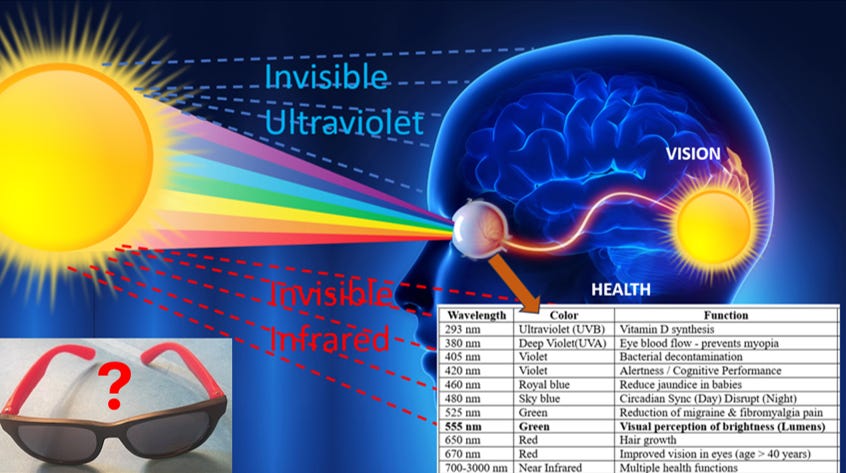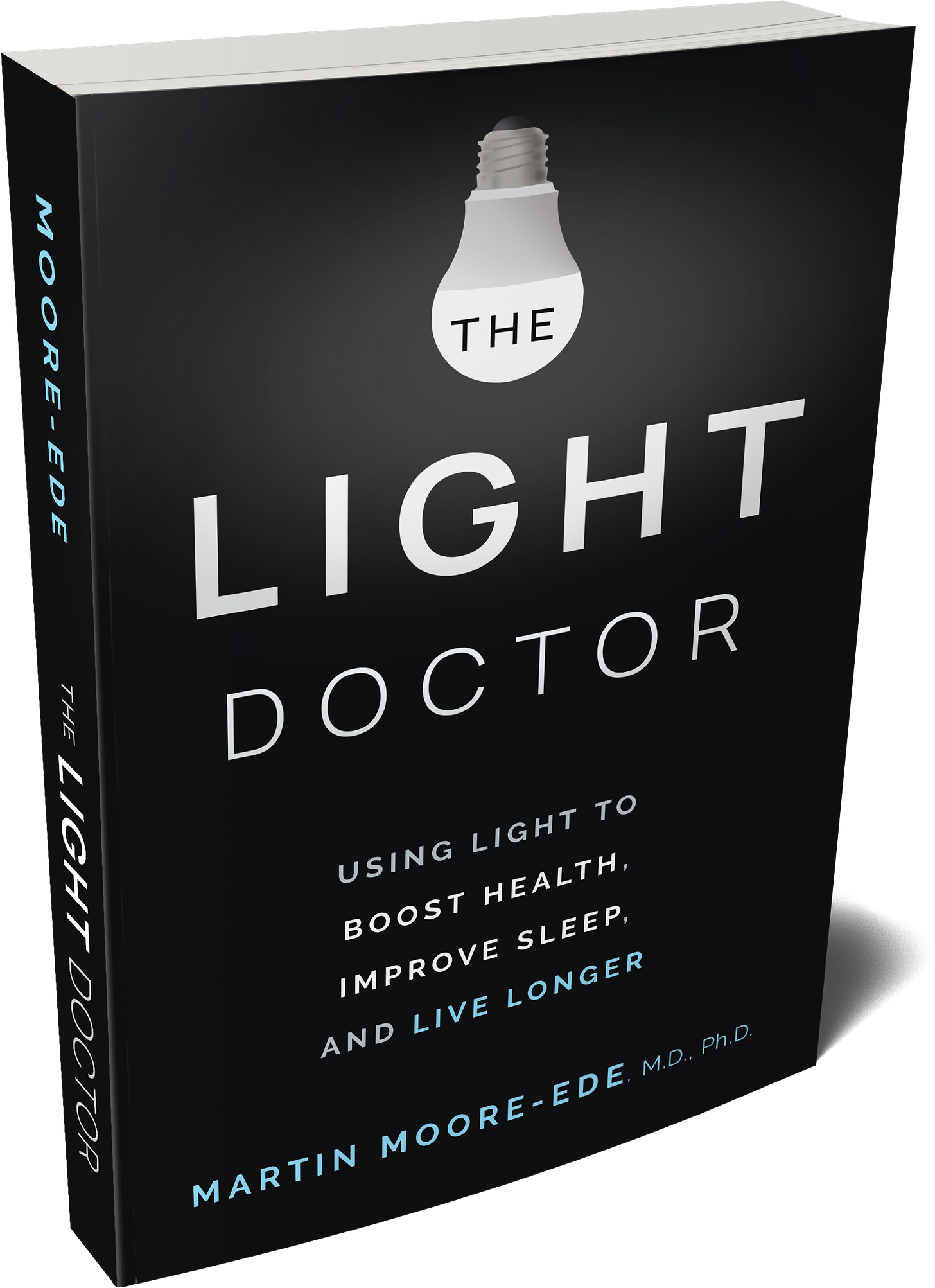Spring has arrived, days are lengthening, and the sky is brightening with increasing intensity of sunlight. So it's time to think about the sunglasses we use.
We normally think of sunglasses in terms of reducing the glare of bright sunlight, but they can also be effective tools for managing our health. But most sunglasses are not well designed for this purpose.
Readers of my book THE LIGHT DOCTOR, and those who subscribe to this bi-weekly Substack newsletter, will know that sunlight contains a wide range of visible and invisible light wavelengths each with specific effects on our health, some positive and some negative.
Rather than providing a uniform blocking of all wavelengths, spectral engineering can be used to promote the health benefits of certain key wavelengths and to block other wavelengths that are harmful.
So here is the question. Which wavelengths should sunglasses block and which should they let through to our eyes?

I don’t wear sunglasses on my morning outdoor walk
There are considerable health benefits to getting outside and being exposed to the full spectrum of natural sunlight or daylight on a cloudy day. In the first half of the morning before the sun has reached its full intensity, I usually do not wear sunglasses because I want to get the full benefits of the sun's natural spectrum.
The only exceptions would be if I'm walking on a snowy landscape in winter that's illuminated by sunlight, or walking on a sandy beach, or riding on a boat where there is considerable glare from the reflection of the sun's rays.
I want to be fully exposed to the sky-blue wavelengths especially between 460 and 495 nm in the morning sunlight that robustly synchronize my circadian clock1. I'm also looking to benefit from the green wavelengths between 525 and 550 nm that calm my amygdala and induce a sense of relaxation2. I also want to benefit from the 670 nm wavelengths in the red part of the spectrum which rejuvenate my eyes as I get older3, and the benefits of near infrared light at around 850 nm which deeply penetrates into my body and rejuvenates the mitochondrial energy generators in my cells4.
But there are undoubtedly many more wavelengths in sunlight that have specific benefits not yet discovered. I also want to get all these other benefits of sunlight of which I'm not yet aware.
Choosing healthy sunglasses
There are many occasions when one should wear sunglasses. When the noonday sun is high in the sky, or when you are driving in sunlight at any time of day, our eyes need protection from glare, and the potential harmful effects of bright sunlight.
When I do wear sunglasses, I want to use those that are spectrally designed to let through the healthy wavelengths and block those that may harm the eye. The wavelengths of most concern are those ultraviolet rays below 360 nm that can cause cataracts and the high energy blue wavelengths between 425 and 450 nm that have been associated with cell death (apoptosis) in the eye. This is only an issue in very bright sunlight as the intensity of light on a cloudy day or indoors runs no risk of damaging the human eye.
Sunglasses tend to be classified by the percentage of visible light transmission. They typically vary between 10 and 40% VLT. However, what really matters is the relative light transmission of the various wavelengths. The chart below shows that there can be a considerable variation between different sunglasses in the spectral transmission percentage across UV, visible, and infrared wavelengths.

I would not consider any of these spectral transmission curves optimal, but the most interesting one is the orange curve which helps prevent eye damage with only 5% light transmission between 425 and 450 nm, while promoting circadian synchronization by allowing 25% transmission of the blue light wavelengths between 460 and 500 nm. It also lets through 70% of light in the red at 670 nm which is known to help boost eye health in the aging eye, and in addition allows a significant amount of infrared light to penetrate.
Each of the sunglasses shown here totally blocks ultraviolet and deep violet light up to about 400 nm. But that may be a problem in children. Recent research suggests that deep violet light between 360 and 400 nm may contribute to preventing the epidemic of myopia (short-sightedness) that is seen in children today5.
Sunglasses for a solar eclipse
For special applications, such as watching a solar eclipse or using welding apparatus, it's essential to block out a much larger portion of light wavelengths. These glasses block out 99.9% of light across the full spectrum.
NASA uses extreme light blocking sunglasses when they need to reorient the circadian clocks of astronauts prior to launch, so they can be at peak performance at a mission-critical window time that would be night time on Earth. Wearing these sunglasses they can go outside during the daytime hours without resetting their circadian clocks.
Sunglasses are an essential part of your light diet
In my book THE LIGHT DOCTOR, I introduced the concept of a Light Diet. Like a nutritional diet, a Light Diet describes the composition of the light you should be exposed to across the 24 hour day to maximize your health and well-being. The use of sunglasses with a healthy spectral transmission curve should be an essential part of the healthy light diet. Unfortunately most sunglasses on the market today don't meet this standard so I am interested in learning from my readers about any sunglasses that they are aware of that are spectrally-designed to support our health.
Remember the light we see is as important our health as the food we eat, the water we drink, and the air we breathe.
Sources
Moore-Ede M et al (2023) Lights should support circadian rhythms: evidence-based scientific consensus. Front. Photon 4: https://doi.org/10.3389/fphot.2023.1272934
Martin LF et al (2021) Evaluation of Green Light Exposure on Headache Frequency and Quality of Life in Migraine Patients: A Preliminary One-way Cross-over Clinical Trial. Cephalalgia 41: 135–147. doi:10.1177/0333102420956711.
Shinhmar H, Hogg C, Neveu M, Jeffery G. Weeklong improved colour contrasts sensitivity after single 670 nm exposures associated with enhanced mitochondrial function. Sci Rep. 2021 Nov 24;11(1):22872. doi: 10.1038/s41598-021-02311-1. PMID: 34819619.
Fosbury R and Jeffrey G (2024) Life-life interactions beyond photosynthesis. https://herschelsociety.org.uk/wp-content/uploads/2024/02/The-Astrophysics-of-Earth_v3.3.pdf
Torii H et al (2016) Violet Light Exposure Can Be a Preventive Strategy Against Myopia Progression. http://dx.doi.org/10.1016/j.ebiom.2016.12.007
Tsubota K (2023) Whitney G. Sampson Lecture: Violet Light Hypothesis for the Control of Myopia Progression. https://www.aao.org/eyenet/academy-live/detail/violet-light-hypothesis






Just wondering how this ties into the school of thought that wearing sunglasses increases risk of sunburn and skin cancer (the eyes being the primary light sensing organ). If the optimal sunglasses are blocking or significantly filtering UV below 350nm, and blue between 425-450nm, what effect will that have on the signalling that typically upregulates the skin's solar defence mechanisms?
RA Optics just came out with new sunglasses called BlueSync - these may meet a lot of your requirements. Scientist Dr. Alexander Wunsch helped develop them...
https://raoptics.com/pages/bluesync